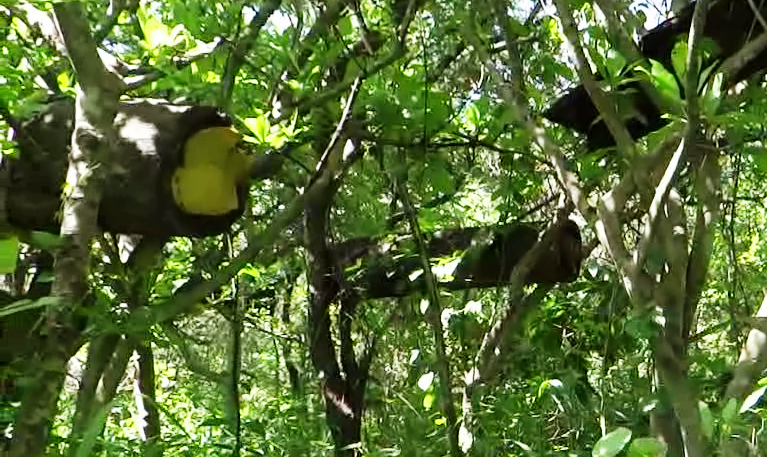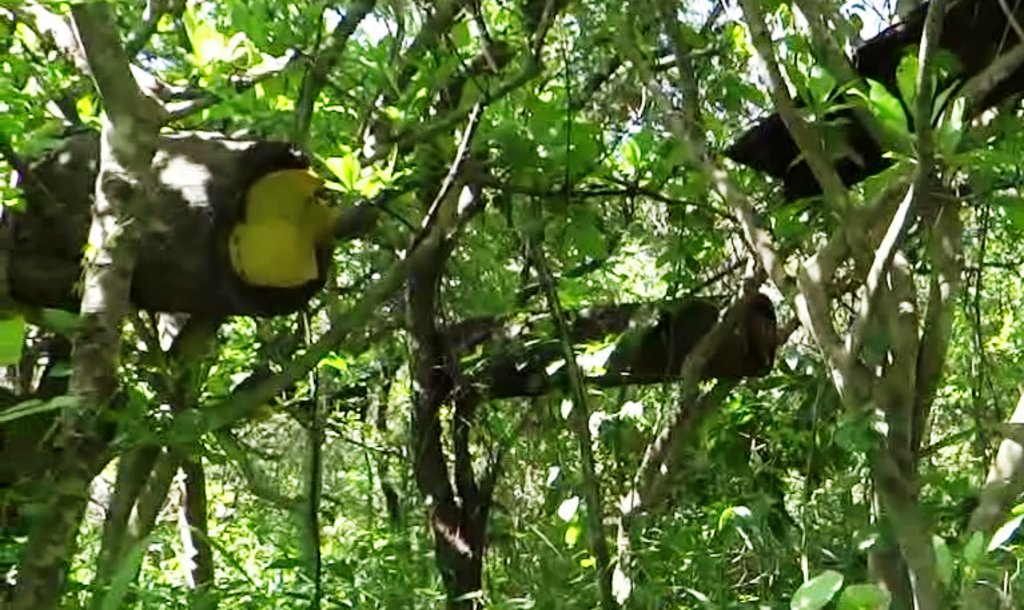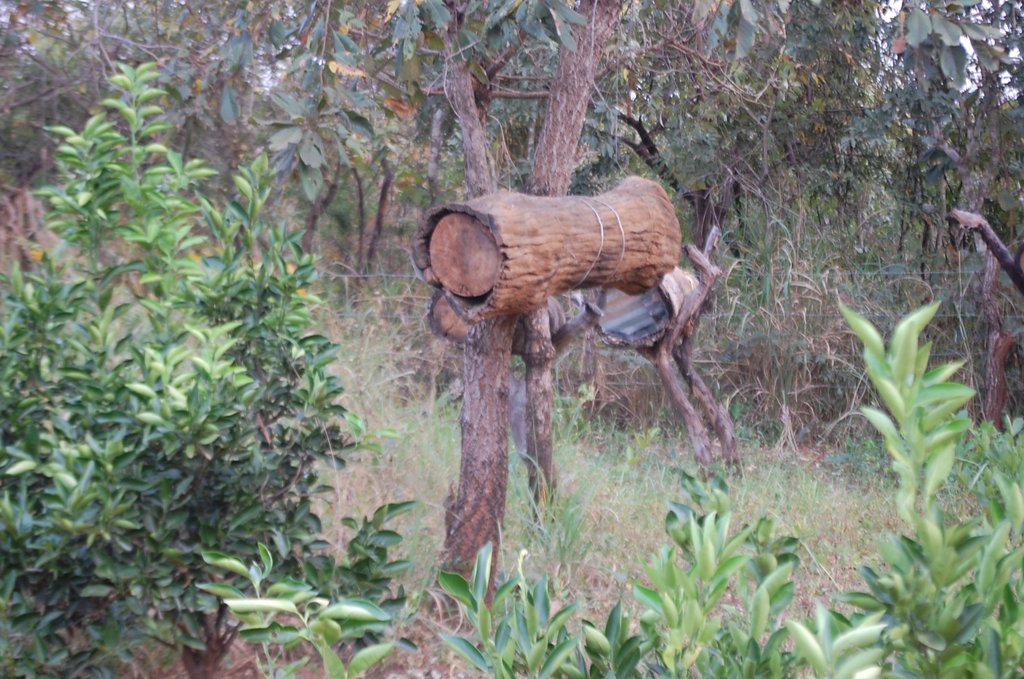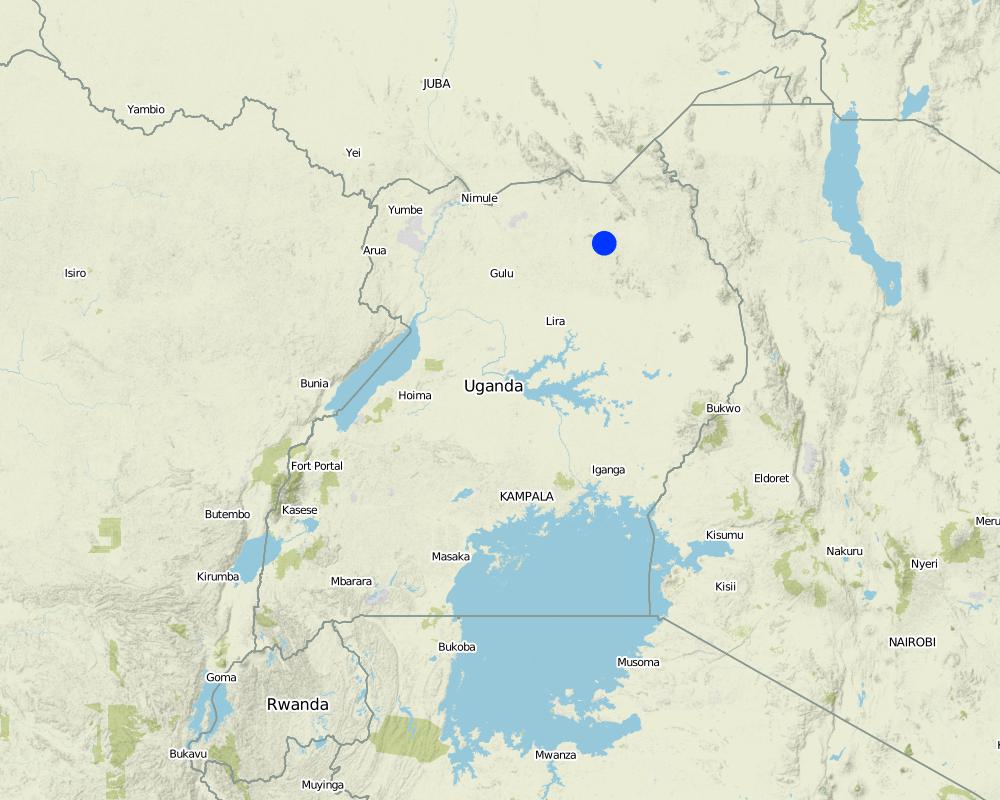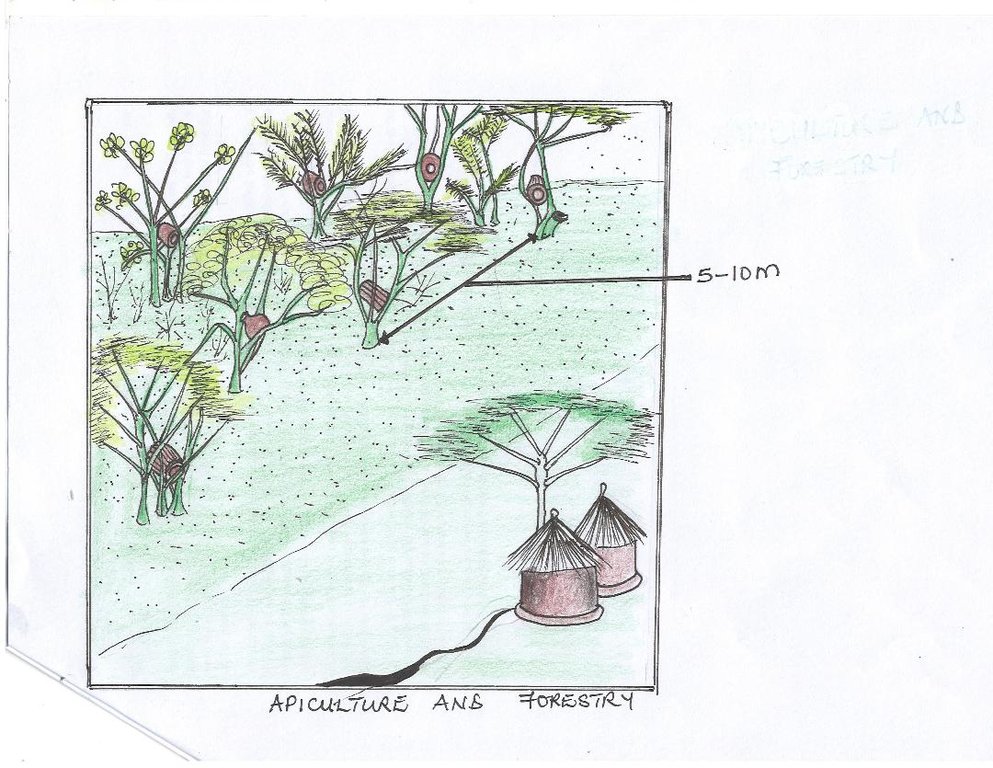Integrated Apiculture and Forestry [乌干达]
- 创建:
- 更新:
- 编制者: Kamugisha Rick Nelson
- 编辑者: JOY TUKAHIRWA, Sunday Balla Amale, Richard Otto Kawawa, Bernard Fungo
- 审查者: Drake Mubiru, Nicole Harari, Renate Fleiner, Stephanie Jaquet, Donia Mühlematter
Penywii bee keepers association
technologies_2257 - 乌干达
查看章节
全部展开 全部收起1. 一般信息
1.2 参与该技术评估和文件编制的资源人员和机构的联系方式
关键资源人
SLM专业人员:
Odora Phillip
0775594364
Penywi beekeeping association
Akwang Village, Taa Parish, Paimol Sub-county,
乌干达
有助于对技术进行记录/评估的项目名称(如相关)
Scaling-up SLM practices by smallholder farmers (IFAD)有助于对技术进行记录/评估的机构名称(如相关)
CDE Centre for Development and Environment (CDE Centre for Development and Environment) - 瑞士1.3 关于使用通过WOCAT记录的数据的条件
(现场)数据是什么时候汇编的?:
10/05/2017
编制者和关键资源人员接受有关使用通过WOCAT记录数据的条件。:
是
1.4 所述技术的可持续性声明
这里所描述的技术在土地退化方面是否存在问题,导致无法被认为是一种可持续的土地管理技术?:
否
2. SLM技术的说明
2.1 技术简介
技术定义:
Maintaining colonies of honey bees within trees and shrubs for environmental conservation and household income.
2.2 技术的详细说明
说明:
Integrated apiculture and forestry technology is promoted and practiced by farmers with small, medium or large scale land holdings of 0.5 acres to 10 with an average of 5-28 local bee hives or more. The farmer may decide to increase the number of the beehives when he sells honey and he gets income.
The farmer (1) identifies the land with trees and shrubs where Local wooden bee hives made in rectangular shape are cited in a distance of not less than 5 -10 metres from one hive to the other (2) Clean the surrounding to reduce the weeds around the cited area (3) cite the beehives within the tree and shrubs (4) keep monitoring bush fires and thieves.
The necessary labour requirements for establishment of this technology include wooden beehives made locally and 4 people to install the bee hives who are paid on daily or monthly basis depending on request.
The benefits from this SLM technology are slightly negative due to the high costs of local bee hives at the time of establishment but positive in the long term of environmental conservation, honey provision and increased income from the sale of honey in addition to using local materials obtained locally associated with low costs.
Wild fires are a common threat during the dry seasons and in order to overcome this issue, it is needed to constantly keep monitoring and establish fire lines to guard against the wild fires
2.3 技术照片
2.4 技术视频
注释、简短说明:
Video link showing Integrated apiculture and forestry in Akwang Village, TAA parish, Paimol Sub-county, Agago District.
日期:
10/05/2017
位置:
Akwang Village, TAA Parish, Paimol Sub-county, Agago District
摄影师的名字:
Rick Kamugisha
2.5 已应用该技术的、本评估所涵盖的国家/地区/地点
国家:
乌干达
区域/州/省:
Northern Region,Uganda
有关地点的进一步说明:
Agago District
注释:
Map showing technology site in Northern Uganda.
Map
×2.6 实施日期
注明实施年份:
2013
如果不知道确切的年份,请说明大概的日期:
- 不到10年前(最近)
2.7 技术介绍
详细说明该技术是如何引入的:
- 通过项目/外部干预
注释(项目类型等):
National Agricultural Advisory Services (NAADS ) supported with training.
3. SLM技术的分类
3.1 该技术的主要目的
- 改良生产
- 减少、预防、恢复土地退化
- 保护生态系统
- 减缓气候变化及其影响
- 创造有益的经济影响
3.2 应用该技术的当前土地利用类型

森林/林地
(半天然)天然森林/林地:
- 选伐
产品和服务:
- 薪材
- 自然保持/保护
注释:
Conserved for bee keeping with selective felling and firewood.
3.3 有关土地利用的更多信息
该技术所应用土地的供水:
- 雨养
每年的生长季节数:
- 2
具体说明:
Harvest twice year during the dry season June /July, December /January
3.4 该技术所属的SLM组
- 森林种植管理
- 养蜂、养殖业、家禽业、养兔业、养蚕业等
3.5 技术传播
具体说明该技术的分布:
- 均匀地分布在一个区域
如果该技术均匀地分布在一个区域上,请注明覆盖的大致区域。:
- < 0.1 平方千米(10 公顷)
注释:
0,5 acres
3.6 包含该技术的可持续土地管理措施

农艺措施
- A1:植被和土壤覆盖层
- A2:有机质/土壤肥力

植物措施
- V1:乔木和灌木覆盖层
- V3:植被的清理

结构措施
- S9:动植物庇护所

管理措施
- M1:改变土地使用类型
3.7 该技术强调的主要土地退化类型

生物性退化
- Bc:植被覆盖的减少
- Bh:栖息地丧失
- Bf:火灾的有害影响
- Bp:害虫/疾病增加,捕食者减少
3.8 防止、减少或恢复土地退化
具体数量名该技术与土地退化有关的目标:
- 防止土地退化
- 减少土地退化
注释:
No cultivation that take place where the bee hives are installed. This reduces and prevents degradation
4. 技术规范、实施活动、投入和成本
4.1 该技术的技术图纸
4.2 技术规范/技术图纸说明
The farmer installs the technology on 0.5 - 10 acres of land with an average of 5-28 local wooden bee hives put in the forest / tree plantation in a distance of not less than 5 -10 metres from one bee hive to the other.
4.3 有关投入和成本计算的一般信息
具体说明成本和投入是如何计算的:
- 每个技术区域
注明尺寸和面积单位:
0.5 acres
其它/国家货币(具体说明):
UGX
注明美元与当地货币的汇率(如相关):1美元=:
3400.0
注明雇用劳工的每日平均工资成本:
5000
4.4 技术建立活动
| 活动 | 措施类型 | 时间 | |
|---|---|---|---|
| 1. | Site selection (location, distance) | 结构性的 | Once before establishment |
| 2. | Look for labour to clear | 其它措施 | Once before estsblishment/ can be routine |
| 3. | Clear the sorrounding | 植物性的 | During establishment/ Routine |
| 4. | Buy the local wooden bee hives | 其它措施 | Once during establishment |
| 5. | Installation of the beehives | 结构性的 | During establishment |
注释:
The farmerrelies on family labour to install the bee hives.
4.5 技术建立所需要的费用和投入
| 对投入进行具体说明 | 单位 | 数量 | 单位成本 | 每项投入的总成本 | 土地使用者承担的成本% | |
|---|---|---|---|---|---|---|
| 劳动力 | Persons days on monthly basis | persons | 4.0 | 150000.0 | 600000.0 | 100.0 |
| 设备 | Bee hives | Pieces | 25.0 | 75000.0 | 1875000.0 | 100.0 |
| 其它 | Transport for bee hives | Number | 1.0 | 250000.0 | 250000.0 | |
| 其它 | 100.0 | |||||
| 技术建立所需总成本 | 2725000.0 | |||||
注释:
High cost of buying local wooden bee hives compared to labour and transport cost.
4.6 维护/经常性活动
| 活动 | 措施类型 | 时间/频率 | |
|---|---|---|---|
| 1. | Slashing | 管理 | Twice a year |
| 2. | Making fireline to pevent fires | 结构性的 | Once a year but this requires maintanance |
| 3. | Monitoring | 管理 | Daily |
| 4. | Supervision | 管理 | Daily |
注释:
Replacement of bee hives is done when the bee hives are spoilt / stolen but this may take longer time without replacement.
4.7 维护/经常性活动所需要的费用和投入(每年)
| 对投入进行具体说明 | 单位 | 数量 | 单位成本 | 每项投入的总成本 | 土地使用者承担的成本% | |
|---|---|---|---|---|---|---|
| 劳动力 | Persons days for slashing, making fireline, monitoring | persons | 4.0 | 150000.0 | 600000.0 | 100.0 |
| 其它 | Transport | 1 | 1.0 | 250000.0 | 250000.0 | 100.0 |
| 技术维护所需总成本 | 850000.0 | |||||
注释:
High costs of labour for maintaining the technology compared to other inputs.
4.8 影响成本的最重要因素
描述影响成本的最决定性因素:
Purchase of bee hives.
5. 自然和人文环境
5.1 气候
年降雨量
- < 250毫米
- 251-500毫米
- 501-750毫米
- 751-1,000毫米
- 1,001-1,500毫米
- 1,501-2,000毫米
- 2,001-3,000毫米
- 3,001-4,000毫米
- > 4,000毫米
指定年平均降雨量(若已知),单位为mm:
1350.00
有关降雨的规范/注释:
Two dry season and two wet season : Dry season June to August and January to February
Wet season: March to May and September to December
农业气候带
- 潮湿的
5.2 地形
平均坡度:
- 水平(0-2%)
- 缓降(3-5%)
- 平缓(6-10%)
- 滚坡(11-15%)
- 崎岖(16-30%)
- 陡峭(31-60%)
- 非常陡峭(>60%)
地形:
- 高原/平原
- 山脊
- 山坡
- 山地斜坡
- 麓坡
- 谷底
垂直分布带:
- 0-100 m a.s.l.
- 101-500 m a.s.l.
- 501-1,000 m a.s.l.
- 1,001-1,500 m a.s.l.
- 1,501-2,000 m a.s.l.
- 2,001-2,500 m a.s.l.
- 2,501-3,000 m a.s.l.
- 3,001-4,000 m a.s.l.
- > 4,000 m a.s.l.
说明该技术是否专门应用于:
- 凹陷情况
5.3 土壤
平均土层深度:
- 非常浅(0-20厘米)
- 浅(21-50厘米)
- 中等深度(51-80厘米)
- 深(81-120厘米)
- 非常深(> 120厘米)
土壤质地(表土):
- 粗粒/轻(砂质)
土壤质地(地表以下> 20厘米):
- 中粒(壤土、粉土)
表土有机质:
- 中(1-3%)
5.4 水资源可用性和质量
地下水位表:
5-50米
地表水的可用性:
过量
水质(未处理):
良好饮用水
水的盐度有问题吗?:
否
该区域正在发生洪水吗?:
否
5.5 生物多样性
物种多样性:
- 中等
栖息地多样性:
- 中等
5.6 应用该技术的土地使用者的特征
定栖或游牧:
- 定栖的
生产系统的市场定位:
- 生计(自给)
- 混合(生计/商业
非农收入:
- 低于全部收入的10%
相对财富水平:
- 平均水平
个人或集体:
- 个人/家庭
机械化水平:
- 手工作业
- 畜力牵引
性别:
- 女人
- 男人
土地使用者的年龄:
- 青年人
- 中年人
说明土地使用者的其他有关特征:
Owns a shop from which she derives more income.
The technology is applied by both men and women but majorly by men. Women use hired men to provide labour.
5.7 应用该技术的土地使用者拥有或租用的平均土地面积
- < 0.5 公顷
- 0.5-1 公顷
- 1-2 公顷
- 2-5公顷
- 5-15公顷
- 15-50公顷
- 50-100公顷
- 100-500公顷
- 500-1,000公顷
- 1,000-10,000公顷
- > 10,000公顷
这被认为是小规模、中规模还是大规模的(参照当地实际情况)?:
- 小规模的
注释:
Own 0.5 acres of land.
5.8 土地所有权、土地使用权和水使用权
土地所有权:
- 个人,未命名
土地使用权:
- 自由进入(无组织)
- 个人
用水权:
- 社区(有组织)
5.9 进入服务和基础设施的通道
健康:
- 贫瘠
- 适度的
- 好
教育:
- 贫瘠
- 适度的
- 好
技术援助:
- 贫瘠
- 适度的
- 好
就业(例如非农):
- 贫瘠
- 适度的
- 好
市场:
- 贫瘠
- 适度的
- 好
能源:
- 贫瘠
- 适度的
- 好
道路和交通:
- 贫瘠
- 适度的
- 好
饮用水和卫生设施:
- 贫瘠
- 适度的
- 好
金融服务:
- 贫瘠
- 适度的
- 好
6. 影响和结论性说明
6.1 该技术的现场影响
社会经济效应
生产
森林/林地质量
注释/具体说明:
The conserved trees and shrubs integrated with bee hives.
土地管理
注释/具体说明:
Where the bee hives are installed, no cultivation and grazing activities are taking place.
收入和成本
农业投入费用
注释/具体说明:
Uses local wooden materials.
农业收入
注释/具体说明:
From the sale of honey.
收入来源的多样性
注释/具体说明:
Sale of honey and firewood.
工作量
注释/具体说明:
Required for Slashing , installation and carrying bee hives during establishment. This reduces over time.
社会文化影响
SLM/土地退化知识
注释/具体说明:
Installation and spacing the bee hives.
Establishing fire line.
生态影响
水循环/径流
地表径流
注释/具体说明:
Presence of protected trees and shrubs.
土壤
土壤覆盖层
注释/具体说明:
Presence of growing vegetation in the apiary.
土壤流失
注释/具体说明:
presence of rees and shrubs protect the soil from run off
土壤有机物/地下C
注释/具体说明:
Decomposition of the leaves from the trees.
生物多样性:植被、动物
植物多样性
注释/具体说明:
More trees and shrubs grow as result of protected apiary.
减少气候和灾害风险
火灾风险
注释/具体说明:
Presence of fireline.
6.2 该技术的场外影响已经显现
水资源可用性
注释/具体说明:
Presence of a check dam where bees get water .
有关影响评估的意见:
Generally the protected trees where the beehives are installed have a positive impact on the environment because no destructive human activities are taking place
6.3 技术对渐变气候以及与气候相关的极端情况/灾害的暴露和敏感性(土地使用者认为的极端情况/灾害)
渐变气候
渐变气候
| 季节 | 气候变化/极端天气的类型 | 该技术是如何应对的? | |
|---|---|---|---|
| 年温度 | 减少 | 好 | |
| 季节性温度 | 湿季/雨季 | 减少 | 好 |
气候有关的极端情况(灾害)
气候灾害
| 该技术是如何应对的? | |
|---|---|
| 森林火灾 | 适度 |
生物灾害
| 该技术是如何应对的? | |
|---|---|
| 昆虫/蠕虫侵扰 | 好 |
6.4 成本效益分析
技术收益与技术建立成本相比如何(从土地使用者的角度看)?
短期回报:
轻度消极
长期回报:
稍微积极
技术收益与技术维护成本/经常性成本相比如何(从土地使用者的角度看)?
短期回报:
轻度消极
长期回报:
稍微积极
注释:
High costs for buying beehives and paying labour compared to benefits which are rather low in the long term associated with obtaining income from the sale of honey.
6.5 技术采用
- 单例/实验
如若可行,进行量化(住户数量和/或覆盖面积):
This is a demosntration for farmers learning.
在所有采用这项技术的人当中,有多少人是自发地采用该技术,即未获得任何物质奖励/付款?:
- 10-50%
注释:
The farmer is a model farmer supported by Operation Wealth Creation. So farmers are encouraged to come and learn without any incentive like transport or any other addtional support.
6.6 适应
最近是否对该技术进行了修改以适应不断变化的条件?:
否
6.7 该技术的优点/长处/机会
| 土地使用者眼中的长处/优势/机会 |
|---|
| Helps control soil erosion because the land user does not dig where the bee hives are established. |
| Provide income from the sale of honey. |
| Can easily be replicated to other areas. |
| Uses locally obtained materials. |
| Easy to establish and maintain with minimum costs when the farmer has enough money. |
| 编制者或其他关键资源人员认为的长处/优势/机会 |
|---|
| The technology uses materials which are locally obtained. |
6.8 技术的弱点/缺点/风险及其克服方法
| 土地使用者认为的弱点/缺点/风险 | 如何克服它们? |
|---|---|
| Requires technical knowledge on spacing and processing wax which is 20% of total honey produced. | Provide training to the land user on how to add value to the wax. |
| The technology is liked by pests (obusinsibirizi) in the local language. | Training on how to control pests for increased production . |
| Thieves like stealing the honey. The technology is a good attraction for thieves. | Facilitate formation of local level by-laws and enforcement of strong fines and bylaws. |
| 编制者或其他关键资源人员认为的弱点/缺点/风险 | 如何克服它们? |
|---|---|
| Affected by Wild fires. | Promote firebreaks to guard against fires. |
7. 参考和链接
7.1 信息的方法/来源
- 实地考察、实地调查
01 - Land user
- 与土地使用者的访谈
01- land user
- 与SLM专业人员/专家的访谈
01 specialist - To provide the compilers or key resource persons view.
链接和模块
全部展开 全部收起链接
无链接
模块
无模块


